
* The Chinese Communist regime established by Mao Zedong began its existence heavily dependent on Soviet-made weapon systems, particularly combat aircraft, obtaining such machines directly from the USSR, and then building them on their own. Gradually the Chinese aircraft industry matured, with the Chinese turning out enhanced derivatives of Soviet designs -- and now, in the post-Mao era, completely Chinese-designed aircraft.
Of course such Chinese designs include fighter aircraft, including the Xian "JH-7 Flying Leopard" strike fighter; the "J-10 Lively Dragon" multirole fighter; the "J-20 Mighty Dragon" stealth fighter -- and its smaller complement, the "J-35". This document provides a history and description of the JH-7, J-10, J-20, and J-35.

* The Chinese were very enthusiastic about the Soviet Mikoyan MiG-19 supersonic fighter, the Chinese Shenyang aircraft organization building it as the "Jianjiji / Jian (Fighter) Type 6" or "J-6". Indeed, although the Soviets saw the MiG-19 as an interim type and did not pursue advanced variants, the Chinese took the design much further by designing a two-seat advanced trainer, the "Jianjiji Jiaolianji (Fighter Trainer) Type 6" or "JJ-6"; and a considerably revised attack derivative of the J-6, the Nanchang "Qianjiji (Attack) Type 5" or "Q-5".
The Q-5 became an important strike asset for both the Chinese People's Liberation Army Air Force (PLAAF) and the People's Liberation Army Naval Air Force (PLANAF). However, its only real virtues were sturdiness and low cost; it couldn't carry a heavy warload, and lacked range. Following armed squabbles with the Vietnamese in the South China Sea in 1974 that revealed deficiencies in Chinese combat capabilities, work began on a much improved strike fighter -- a two-seat aircraft with a hefty warload and long range. In 1976, a request for proposals (RFP) was sent out to Chinese aircraft design organizations; in 1977, the proposal submitted by the Xian Aircraft Factory was accepted for further development. At the outset it was seen effectively as a pure bomber, with the aircraft to be designated "Hongzhaji / Hong (Bomber) Type 7" or "H-7".
The PLAAF and the PLANAF had different requirements, and so Xian engineers designed two different variants -- one with side-by-side seating for the PLAAF, the other with tandem seating for the PLANAF. However, at that time China was only just emerging from the turmoil of the disastrous Cultural Revolution, initiated by Chinese Communist Party (CCP) Chairman Mao Zedong in 1966, which had done much to reduce the country to chaos for a decade. Getting things done was difficult enough; the Xian design was also of Chinese origin, not a derivative of a Soviet type, presenting a challenge to the inexperienced Chinese aviation industry. Developing two different variants was simply too much, and the program went nowhere in particular.
By the early 1980s, it was apparent that both variants could not be implemented, and PLAAF interest in the H-7 gradually faded out. However, the Chinese military took careful notice of the 1982 Falklands War between Britain and Argentina, paying considerable attention to the Argentine use of French-made Exocet antiship missiles against British vessels. Chinese maritime war planning was revised to focus on antiship missiles, and that implied obtaining an air platform that could carry and launch them. Accordingly, the PLANAF pushed development of the H-7, the concept being revised to a multirole configuration and accordingly redesignated "Jian Hong (Fighter Bomber) Type 7" or "JH-7".
* The development program then got out of its holding pattern and began to move forward. Subsystems for the JH-7 were evaluated on various trials aircraft such as the H-5 torpedo bomber -- a Chinese copy of the Soviet Il-28 "Beagle" bomber -- and the JJ-6 advanced trainer, while tests were performed of the Chinese-made WS-6 afterburning bypass jet engine, expected to be the powerplant for the JH-7. However, Chinese engine development was also inexperienced, and the WS-6 would never go into production; the British Rolls-Royce Spey Mark 202 engine was selected instead, with development to be performed on Speys acquired from the UK and, in principle, production to use Chinese-built copies. The Spey wasn't a particularly modern engine, but it was known to be reliable, and its specifications were an adequate fit for the mission.
It appears that five JH-7 prototypes were built, the first flight being on 14 December 1988. They were followed by "Block 1" evaluation machines, and then "Block 2" full-production machines. The JH-7 was formally accepted into service until 1998, though it appears it was in PLANAF squadron service by 1994. It was followed by a "JH-7A", essentially the mature production version of the JH-7, which entered service in 2004. The earlier-production JH-7s were apparently given partial upgrades to bring them closer to JH-7A spec. A "JH-7A2" was revealed at an airshow in 2021, apparently featuring avionics updates, and particularly the ability to carry more combat load, including new munitions.

Over 270 JH-7-series strike fighters have been built to date; it has been offered for export sales as the "FBC-1 Flying Leopard", but there have been no export users. It was assigned the unflattering NATO reporting name of "Flounder", though it is often, at least informally, known by the "Flying Leopard" name.
BACK_TO_TOP* The JH-7A turned out to be a muscular-looking combat jet made mostly of aircraft aluminum alloys, featuring a slab-sided fuselage; all-swept flight surfaces with a high wing; twin engines fed by dee-style inlets on the sides of the fuselage behind the cockpit; and tandem seating. Each wing had a sweepback of 45 degrees at quarter-chord, with a small "leading edge root extension" featuring greater sweep. The wing arrangement was straightforward, with ailerons and large one-piece flaps, but no leading-edge control surfaces; the wings had a strong anhedral droop. The tailfin had a prominent forward fillet, and the tailplanes were "all moving". There were twin fixed ventral fins under the tail -- the JH-7 only had one ventral fin -- and airbrakes top and bottom just forward of the engine exhausts, for a total of four airbrakes.
Each of the engines provided 54.51 kN (5,550 kgp / 12,250 lbf) dry thrust and 91.29 kN (9,300 kgp / 20,515 lbf) afterburning thrust. The dee-type inlets were of fixed configuration, with splitter plates to avoid ingestion of stagnant "boundary layer" air, and two prominent auxiliary doors on the side of each engine nacelle, forward of the wing.
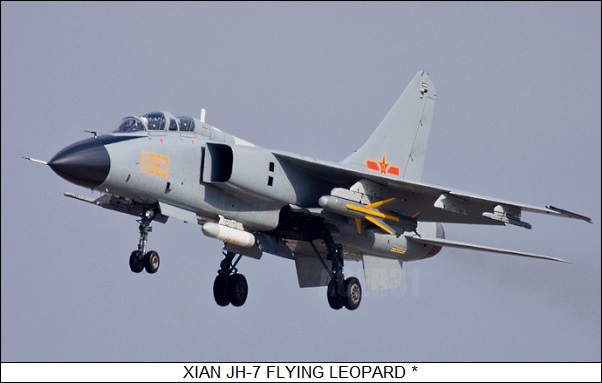
Originally the powerplants were Spey Mark 202s obtained from Rolls-Royce in Britain, with the plan being to produce them in China. Copying the Spey proved difficult, and additional Speys had to be purchased to support the JH-7 program -- most of the engines being refurbished units from retired British Phantom fighters. The locally-produced version, the WS-9, was not introduced until after the turn of the century; that was an embarrassment, but manufacturing the Spey did prove a significant learning experience for the Chinese jet engine industry.
All landing gear had twin wheels, presumably for operation off rough airstrips, the nose gear retracting backward and the main gear retracting up and forward into the fuselage. On the approach, with gear down, the JH-7A had an unmistakeable resemblance to an Anglo-French two-seat SEPECAT Jaguar strike fighter, the resemblance not being so strong from other angles. The Jaguar was obviously seen as a model of the sort of aircraft the Chinese wanted to build, though it would be absurd to call the Flying Leopard a "copy" of the Jaguar in any significant way. It could be thought of as a "Jaguar on steroids", the JH-7A having an empty weight about twice that of the Jaguar.
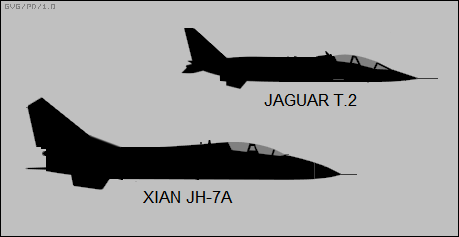
The two aircrew sat on zero-zero (zero-altitude zero-speed) ejection seats, under individual rear-hinged clamshell canopies. The JH-7A differed from earlier production JH-7s by featuring a one-piece windscreen. The seats were offset to give the back-seater a better forward view. Avionics of the JH-7A were state-of-the-art for Chinese technology, featuring:
___________________________________________________________________
XIAN JH-7A:
___________________________________________________________________
wingspan:
12.7 meters (41 feet 8 inches)
wing area:
52.3 sq_meters (563 sq_feet)
length:
22.325 meters (73 feet 3 inches)
height:
6.575 meters (21 feet 7 inches)
empty weight:
14,500 kilograms (31,900 pounds)
MTO weight:
28,475 kilograms (62,775 pounds)
max speed at altitude:
1,210 KPH (750 MPH / 655 KT)
service ceiling:
15,600 meters (51,180 feet)
combat radius:
1,650 kilometers (1,025 MI / 890 NMI)
___________________________________________________________________
The JH-7A had internal armament, in the form of a two-barreled Type 23-III "teeter-totter" 23-millimeter cannon, a variant of the Soviet GSh-23 cannon, on the lower right side of the fuselage, roughly near the wing leading edge -- a position that no doubt reduced problems with engine gun-gas ingestion. All stores were carried externally, with stores attachments including:
The JH-7A could carry AAMs, typically a short-range AAM on each wingtip station and a larger AAM on each outboard wing pylon. Possible AAM armaments included:
Offensive weapons included iron bombs, cluster munitions, unguided rocket pods, guided bombs, anti-radar missiles, and antiship missiles -- with four antiship missiles being more or less a default operational stores configuration. Total external warload is given as a hefty 8 tonnes (8.8 tons). It could also be configured for the electronic warfare (EW) role, carrying jamming pods on its underwing pylons, with three different types of jamming pods having been identified.

While a capable aircraft and certainly a big step forward for the Chinese aircraft industry, the Flying Leopard was a design rooted in the 1960s and 1970s, technologically a contemporary of the Jaguar, and well behind the times for the 21st century. There have been efforts to keep the JH-7 up to date, with initial flight of a "JH-7B" upgrade in 2011. Although little information is available, it appears that the primary elements of the update were a new radar and mission computer, plus an inflight refueling probe. It may also have introduced some composite assemblies, to reduce weight, and an improved WS-7B engine.
A "JH-7AII" was announced in 2019. It was externally hard to tell from a JH-7A, with improvements apparently consisting of new avionics, including updated radar and mission computer, with better integration of ECM pods. However, China has been moving on to more sophisticated aircraft, and it's hard to say how long the JH-7 will stay in service.
BACK_TO_TOP* During the Mao years, the PLAAF focused on the J-6 fighter and the more modern "J-7" fighter, which started life as a Chinese-built Mikoyan MiG-21. The Chinese would considerably enhance the J-7 design, leading to the "JF-17 / FC-1" lightweight fighter" and the "FTC-2000 / FL-9" fighter trainer. The Chinese also developed a heavy interceptor, the "F-8", which started life more or less as a scaled-up twin-engine J-7 / MiG-21. From the 1990s, the PLAAF began to acquire more modern and formidable fighters, focusing on derivatives of the Russian Sukhoi Su-27, built in China as the "J-11", as twin-engine heavy fighter / fighter-bomber assets. The PLAAF was also supporting in parallel the development of a smaller single-engine fighter, seeking a design of Chinese origin.
Work on the single-engine fighter began in 1983 as "Project 10", with an RFP released specifying a jet fighter comparable to those possessed by potential adversaries -- such as the F-16, F/A-18, Mirage 2000, MiG-29. The major Chinese aircraft organizations responded with proposals, the Chengdu organization's proposal being selected for further development in 1984. Development was protracted, with engine development problems apparently being a significant cause of delays, but the first prototype of the "J-10A Meng Long (Vigorous / Energetic / Lively Dragon)" was, according to official records, rolled out in 1997, with the first flight on 23 March 1998, test pilot Le Qiangjia at the controls.
Estimates of the number of prototypes run to about a half-dozen, with these machines inelegantly taking to the air in yellow primer paint. Following the end of initial trials in early 2003, a number of aircraft were provided to a PLAAF operational conversion unit, with the J-10A then entering PLAAF line service in 2004. In the meantime, work had been proceeding on a two-seat version, the "J-10S", with the initial prototype performing its first flight in late 2003 and the variant introduced to service in 2006.

* As it emerged, the J-10 was an attractive canard-delta machine, with a configurational -- though not detail -- similarity to the European Typhoon advanced fighter. It had:
Each wing featured an inboard and outboard control surface on the trailing edge of the wing -- usually referred to as "elevons" for "elevator-ailerons", but the distinction between flaps, elevators, and ailerons can get confusing in a canard delta machine. The wing also had a drooping leading-edge flap on the outer two-thirds of its span. The inboard section of the wing had an anhedral droop while the outboard section was flat, giving the wing a slight "inverted gull" configuration.

The powerplant was originally the Russian AL-31FN afterburning low-bypass fan jet, providing 79.54 kN (8,100 kgp / 17,860 lbf) dry thrust and 122.6 kN (12,500 kgp / 27,560 lbf) afterburning thrust. It seems difficulties with Chinese development of an adequate powerplant almost killed the J-10 program, with acquisition of the Russian powerplant keeping it alive. The comparable Chinese WS-10 engine has been introduced to replace the AL-31FN, being in service from 2021; the WS-10B engine variant has a reported afterburning thrust of 144 kN (14,500 kgp / 32,000 lbf). The WS-10 is seen as a stepping stone to the definitive WS-15 engine, with substantially more thrust.
___________________________________________________________________
CHENGDU J-10 LIVELY DRAGON:
___________________________________________________________________
wingspan:
9.75 meters (32 feet)
wing area:
33.1 sq_meters (356.3 sq_feet)
length:
15.49 meters (50 feet 10 inches)
height:
5.43 meters (17 feet 10 inches)
empty weight:
9,750 kilograms (21,495 pounds)
MTO weight:
19,275 kilograms (42,500 pounds)
max speed at altitude:
Mach 2.2
service ceiling:
18,000 meters (59,400 feet)
combat radius:
550 kilometers (340 MI / 300 NMI)
___________________________________________________________________
Avionics configuration was unclear, evident features being a glass cockpit with a head-up display (HUD) plus "hands on throttle and stick (HOTAS)" controls, along with a planar-array multimode radar and a defensive countermeasures system. The aircraft was dynamically unstable, with a digital FBW FCS to keep it in the air.
The J-10 had a twin-barrel Type 23 23-millimeter cannon on the belly, offset to the left. There was a centerline pylon, primarily for a belly tank, and pairs of small pylons fore and aft of the centerline store on the belly. Each wing had three stores pylons, the innermost being "wet" for an external tank.
Typical armament configurations seen on the J-10 strongly suggested it was seen as an air superiority / control asset. It could carry the PL-5 and PL-8 heat-seeking AAMs -- photos suggested the PL-8 is the preferred store -- as well as the PL-11 Aspide / Sparrow derivative, and the newer PL-12 -- also a preferred store, along the lines of the US AIM-120 AMRAAM and featuring an active radar seeker. A full warload included a PL-8 on each outer pylon, for a total of two; a PL-12 on each midwing pylon and on the four fuselage "corner" pylons, for a total of six; and an external tank on each inner pylon and on the centerline pylon, for a total of three.
For some time, it was difficult to see that the J-10 had an air-to-ground capability, beyond unguided rocket pods -- a fairly easy store to use, since they can be aimed by a gunsight -- but in 2016, the PLAAF announced that the J-10 had been qualified with a target designator pod, mounted on an under-intake pylon, the pod having originally been fielded on the JH-7. In 2017, a J-10B was displayed kitted up for the "defense suppression" role, with twin YJ-91 anti-radar missiles, these being developed from the Russian Kh-31 ramjet-powered air-to-surface missile; a control pod for the YJ-91s; and an electronic systems pod, clearly for targeting the missiles.
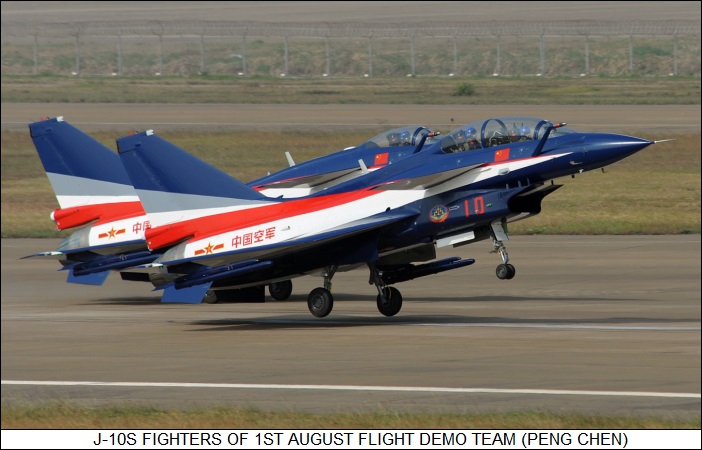
The J-10S two-seater was generally similar to the single-seater, except of course for the tandem-seat cockpit, as well as a noticeable dorsal spine. It appears that the initial use of the two-seater was for conversion training, but it had obvious potential as a multirole aircraft -- indeed, had it been intended primarily as a trainer, it would have had a designation along the lines of "JJ-10". A photo of a J-10S was available showing it kitted up with targeting pods on the forward fuselage pylons, as well as air-to-surface stores. The two-seat configuration of the J-10S made it better suited to the attack role, with a weapons system operator in the back seat targeting and directing weapons. However, it's unclear just how well developed this "Strike Dragon" configuration really is.
* Several hundred J-10s are now in PLAAF service, with the type notably being used as the mount for the PLAAF "August 1" flight-demonstration team, having replaced the J-7 / MiG-21 in that role from 2009. These six machines are painted in spiffy blue-white-red colors and carry smoke generators to "wow the crowd". Incidentally, the significance of the date is that it is the formal birthday of the PLAAF. The PLANAF also operates the type, with the single-seater for the PLANAF being the "J-10AH", and the two-seater being the "J-10SH". An improved "J-10B" has been introduced, with:
Confusingly, a "J-10C", with advanced avionics but the AL-31FN engine, was introduced to service in 2017, so the exact path to the future is a bit unclear for the present. Pakistan has obtained the J-10C, with at least a dozen delivered from 2022, and more to follow. A J-10 with an enlarged "fat spine", presumably to house more avionics, or less possibly fuel, was observed in 2022. No details were available, with speculations that the aircraft in question could be a demonstrator for a defense-suppression or electronic countermeasures aircraft.
BACK_TO_TOP* In the late 1990s, the PLAAF initiated a program to develop a "fifth generation" fighter to compete with the US Lockheed Martin F-22 Raptor and other emerging equivalents. The effort was designated "Project 718", with Western intelligence labeling the proposed new aircraft as "J-XX".
A decade later, after evaluating candidate designs from the Shenyang and Chengdu organizations, the PLAAF selected the Chengdu design for further development. By 2010 two prototypes of the Chengdu "J-20" had been rolled out, with the initial flight of the type on 11 January 2011, test pilot Li Gang at the controls. Names associated with it included "Mighty Dragon", "Black Eagle", and "Black Silk", though an official name wasn't announced.
A second prototype took to the air in May 2012, followed by a third of refined configuration, with many tweaky airframe changes, in March 2014, and then a similar fourth prototype in July 2014. The first two prototypes were effectively demonstrators; the second were more like production machines. After a hiatus, five further aircraft appeared. Two of them were prototypes, bringing the total to six, the other three being initial production machines. The PLAAF received their first service machines late in 2016, being initially flown for operational test and training; introduction to service was in 2018.
Not much has been officially announced on the J-20, and so all that can be said about it is conjectural, based on imagery released of the aircraft -- though there's been considerable imagery released, providing a good set of clues. The configuration of the J-20 was straightforward, being a twin-engine canard-configuration aircraft featuring blended contours, with twin tailfins and matching fixed ventral fins. The demonstrators probably had significant titanium elements but modest use of composites, the Chinese being judged as in development of composite aircraft structures.
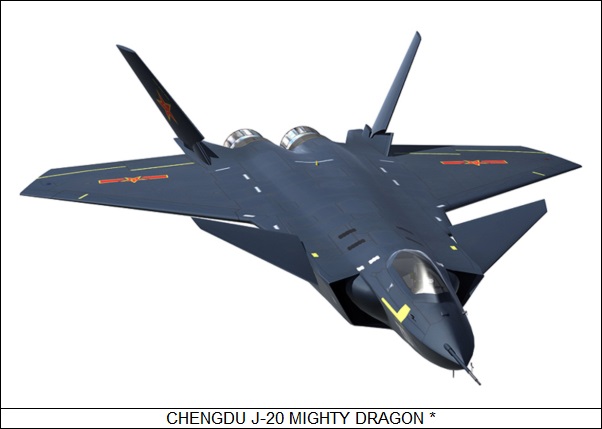
The wing arrangement was like that of the J-10, with twin control surfaces on the trailing edge of the wing and a full-span drooping leading-edge flap. The tailfins and canards were of "all-moving" configuration; the ventral fins were fixed. The J-20 had tricycle landing gear, all gear assemblies having single wheels, the nose gear retracting forward, the main gear tucking up and forward into the sides of the fuselage; the gear doors had sawtooth "stealthy" edges. Later prototypes featured a stealth radar-absorbent coating.
Twin cruciform drag chutes could be deployed to reduce landing roll. The cockpit had a single-piece canopy that hinged up from the rear. The refined third prototype featured alterations to flight surfaces, revised landing gear door configuration and canopy, plus additional "warts" on the aircraft for combat avionics systems.
Prototype J-0s used Russian-built AL-31FN afterburning low-bypass fan jets, as used by the J-10. The production powerplant is the WS-10G with thrust-vectoring nozzles, with the WS-15 again expected to be the definitive powerplant.
___________________________________________________________________
CHENGDU J-20 MIGHTY DRAGON (ESTIMATED SPECIFICATIONS):
___________________________________________________________________
wingspan:
12.88 meters (42 feet 3 inches)
wing area:
59 sq_meters (630 sq_feet)
length:
21.26 meters (69 feet 6 inches)
height:
4.45 meters (14 feet 7 inches)
empty weight:
17,000 kilograms (37,480 pounds)
MTO weight:
36,285 kilograms (80,000 pounds)
max speed at altitude:
2,100 KPH (1,305 MPH / 1,135 KT)
service ceiling:
18,000 meters (59,400 feet)
range:
3,400 kilometers (2,115 MI / 1,840 NMI)
___________________________________________________________________
As far as other basic elements of the aircraft -- when not actually specified, they could be assumed: zero-zero ejection seat; glass cockpit with wide-screen color flat-panel displays, HUD, helmet-mounted sight, and HOTAS controls; a flight processor system and multiplex digital FBW FCS; plus modern countermeasures kit. Production J-20s likely carry a multimode AESA radar of Chinese manufacture. There are also windows on the fuselage that have been judged to be for a "distributed aperture" threat-warning system. Avionics systems were tested on a highly modified Russian Tupolev Tu-204C twinjet airliner -- along the lines of the modified Boeing 757 called the "Catfish", used to test systems for the Lockheed Martin F-22 Raptor fighter.
J-20s are fitted with an internal cannon, presumably a single 30-millimeter rapid-firing weapon. There was a large weapons bay in the belly -- photographed to be carrying four PL-15 long-range AAMs, a new weapon similar to the US AIM-120 AMRAAM, but slightly bigger; other stores were of course possible flanked by a small weapon bay on each side -- for a short-range AAM, such as the new PL-10, an agile weapon along the lines of the British ASRAAM or US AIM-9X, cued by a helmet-mounted sight. The aircraft featured eight hardpoints for external stores carriage; photos have shown of it carrying four external tanks.
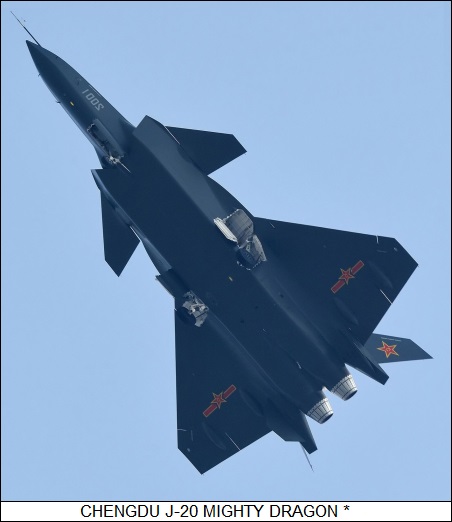
There's been some puzzling over the specific role intended for the J-20; while seemingly well-suited as a stealthy strike asset, the carriage of long-range AAMs suggests it may also be seen as a long-range interceptor to neutralize adversary air assets. There is no higher strategic priority to China than the consolidation of Taiwan with the mainland; to this end, the Chinese have focused on neutralizing Taiwanese and US air power in the region, accordingly investing in interceptors, with each interceptor carrying a heavy AAM load.
* The Chinese have made it clear they have no intention of exporting the J-20. AVIC is talking about development of a two-seater.
BACK_TO_TOP* In the summer of 2012, the Chinese unveiled yet another stealth demonstrator, the Shenyang "FC-31 Gyrfalcon", it seems originally intended for export sales. It was characterized a "lightweight fighter", of stealthy configuration. The Gyrfalcon had twin engines and twin tailfins like the J-20, but with all-moving tailplanes instead of canards; it somewhat resembled a US Lockheed Martin F-35 fighter, but with twin engines. A second prototype, with many changes and closer to production standard, appeared in late 2016.
A carrier version, designated the "J-35", emerged in 2021, featuring twin-wheel nose gear, a catapult launch bar, arresting hook, and folding wings. It dispensed with the bubble canopy seen earlier, for a canopy with no rear view. A fourth prototype of a land-based variant, the "F-35A", flew in 2023, with another F-35A prototype appearing in 2024. The type apparently entered production in 2025, with Pakistan intending to obtain the F-35A as the FC-31. It is not clear if China wants to obtain the F-35A along with the F-35 carrier variant.
___________________________________________________________________
SHENYANG J-35:
___________________________________________________________________
wingspan:
11.5 meters (37 feet 9 inches)
length:
17.3 meters (56 feet 9 inches)
height:
4.8 meters (15 feet 9 inches)
MTO weight:
28,000 kilograms (61,730 pounds)
max speed at altitude:
2,200 KPH (1,370 MPH / 1,200 KT)
service ceiling:
16,000 meters (52,000 feet)
operational radius with external tanks:
2,000 kilometers (1,200 MI / 1,840 NMI)
___________________________________________________________________
The J-35 is apparently powered by twin WS-21 afterburning low bypass fan jets with roughly 89 kN (9,070 kgp / 20,000 lbf) afterburning thrust. The aircraft's armament includes the PL-10 short-range missile, the PL-15 long-range AAM, along with 8 small diameter bombs, land attack missiles, anti-radiation missiles, and antiship missiles. The FC-31 can carry 2,000 kilograms (4,400 pounds) of stores in its single internal bay, and 6,000 kilograms (13,220 pounds) externally on 6 pylons.

There have also been hints that Chengdu is developing an advanced vertical take-off & landing (VTOL) fighter, an announcement having been made that the organization is developing an engine for a VTOL machine. There have long been rumors that the Chinese might be developing a derivative of the Russian Yakovlev Yak-41 -- a VTOL fighter developed before the collapse of the USSR -- though notional designs released so far suggest an aircraft along the lines of the US F-35B, but with canard foreplanes. Other rumors suggest the designation of the machine is "J-18". For now, we just wait and see.
BACK_TO_TOP* Sources include:
The online Wikipedia and several volumes of JANE'S ALL THE WORLD'S AIRCRAFT were also mined for details.
* Revision history:
v1.0.0 / 01 sep 15 v1.1.0 / 01 aug 17 / General update. v1.1.1 / 01 jul 19 / Review, update, & polish. v1.2.0 / 01 may 21 / Review, update, & polish. v1.3.0 / 01 jul 23 / Review, update, & polish. v1.3.1 / 01 jul 23 / Review, update, & polish. v2.0.0 / 01 jul 25 / New J-35 section. (*)BACK_TO_TOP
